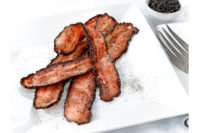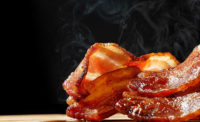Bacon has become a bright spot in the day, all times of the day, for consumers, retailers, foodservice and processors alike. In retail, Information Resources Inc. (IRI), Chicago, reports bacon is performing very strongly, and in turn retailers are placing more bacon items on grocery shelves. Bacon is purchased by 75 percent of U.S. households, and on average U.S. families buy 10 pounds of bacon a year, IRI says.
“What we’re seeing is a real explosion in sales around flavors, and it’s also the source of where a lot of innovation is coming,” says Chris DuBois, senior principal for IRI. “We are seeing lots of new items with more elaborate flavors.”
Cherrywood-, applewood- and hickory-smoked bacons along with thicker cut bacons have been extremely popular, DuBois says.
Bacon’s volume growth is a compilation of several factors, DuBois says, including the fact that one of the largest U.S. population segments, millennials, are forming families and including bacon in their weekend breakfasts. The rise in cooking shows and emphasis on cooking at home also is helping grow bacon sales for retailers, he says.
Mintel International, Chicago, reports bacon sales have been on the rise for most of the last decade. “It’s not so much consumer interest in specific brands, but you are seeing some brands doing very well,” says Billy Roberts, a senior analyst of food and drink for Mintel International, Chicago. “For example, Oscar Mayer has done particularly well, but consumers are almost regarding bacon as a commodity. They are perfectly willing to trade down to the private label version of bacon because a lot of consumers view bacon as good. It’s its own selling brand. Bacon is a brand into itself almost. In the same turn, it’s not like that trading down has impacted sales at all. Sales have continued to increase even as consumers are embracing private label options.”
Roberts agrees that consumers are interested in and seeking out bacons with new, unique flavors and more robust flavor profiles. “We are seeing more jalapeno flavors and hotter and spicier flavors,” Roberts explains. “More sweet flavors, too, like barbecue-flavored options are appearing in the marketplace and capturing consumer interest of having a sweetness to the bacon.”
Restaurants flaunt bacon
In foodservice, bacon has grown steadily since 2005 and is featured on 70 percent of all U.S. menus, up 11 percent since 2005, reports Datassential, Chicago. Bacon has grown 3 percent on menus during the last four years.
“Bacon’s demand is proportional to its versatility,” says Joe Garber, marketing coordinator at Datassential. “It can be used across the menu from a breakfast ingredient or side to a topping on burgers and sandwiches, sautéed with veggies or paired with chocolate in a dessert. Its salty, meaty profile is a good balance to many dishes.”
In turn, bacon has remained a steady ingredient and menu item at restaurants during the past decade and has grown at all parts of the day. Because of this, a number of bacon varieties are growing including: applewood-smoked bacon (up 40 percent on menus during the last four years), pepper bacon (up 21 percent on menus during last four years) and turkey bacon (up 18 percent during last four years), Datassential reports.
In terms of innovation, unique bacon varieties, such as lamb and duck, are making their way from home kitchens to operator menus on just about any dish traditional pork bacon can be found. “The key uses of these include comfort foods, breakfast dishes and center-of-plate entrees,” Garber says.
Bacon-wrapped items also appear on 8 percent of menus, up 13 percent during the last four years, Datassential reports. Appetizer offerings include items such as bacon-wrapped shrimp, scallops and dates.
In addition, bacon jam is the No. 1 growing condiment/spread for sandwiches, particularly burgers. “It’s grown 90 percent over the last year, but is only on 1 percent of menus,” Garber says. “It tops tomato jam and sriracha sauce.”
For foodservice, bacon in dessert is another innovative area. For example, at Which Wich, any milkshake can become a Bacon Milkshake with four strips of bacon and a bacon straw. Seasonally, QuikTrip also offers a made-to-order Maple Bac’n QuikShake featuring strips of cooked bacon and maple syrup.
Bacon is also included in many foodservice chains limited-time-offerings, including Little Caesar’s Bacon Wrapped Crust Deep! Deep! Dish Pizza, wrapped in 3.5 feet of bacon plus pepperoni and bacon on top. For a limited time, Ram Restaurant & Brewery offered PBB&J Burger — a brioche bun, seasoned grilled beef patty, jalapenos, cheddar-jack cheese, applewood-smoked bacon and peanut butter.
Emphasizing more times of day
While the majority of bacon consumption occurs in the morning, bacon is no longer something that’s reserved for the morning hours.
“It’s a delicious, versatile product that can be worked into any meal of the day,” says Mike Merritt, senior director of brand marketing for Smithfield Foods. “Whether that’s breakfast, lunch or dinner, sandwiches or salads, drinks or desserts, there are endless ways to enjoy bacon and we’re seeing that consumers are doing just that. Also, with the rise of the all-day breakfast trend, consumers are eating more bacon than ever.”
Year-to-date, Smithfield Bacon sales are up 28 percent in volume and 43 percent in dollar sales from this same period in 2015, the company reports.
“As a leader in the protein category, we at Smithfield Foods want to continue to ensure that we’re providing fans with new, unique ways of enjoying bacon and are constantly challenging ourselves to come up with innovative flavors that our customers of all ages can enjoy,” Merritt says. “Last year, we launched several new smoked flavors, including Applewood and Cherrywood, and this year we’re excited to offer consumers a limited-time-only Brown Sugar and Bourbon Bacon this fall.”
While Smithfield’s Hometown Original Bacon remains its No. 1 seller across the country with 50 percent of all domestic sales, the popularity of its newer smoked bacon flavors, such as Applewood and Cherrywood, continue to grow rapidly. “In fact, over the past year, we’ve seen sales of our Applewood Smoked Thick Cut Stack Pack Bacon grow almost 70 percent, even after being in the market over three years,” Merritt says.
Bill Andreetta, president of Sunnyvalley Smoked Meats Inc., Manteca, Calif., agrees that consumers are using bacon in so many more ways and that chefs across the country are creating new dishes using bacon as well. “Bacon is a good added value wrapped around a tenderloin or chicken breast,” he says.
Sunnyvalley Smoked Meats, which currently slices more than 1 million slices of bacon a day five to six days a week, still sees Hickory Smoked Bacon as its top seller. That being said, the company answered consumer demands for more flavors and offers Maple, Pepper, Cherrywood and Applewood and recently launched Sweet and Spicy Bacon. While flavored bacons are still the biggest sales driver, uncured bacon, especially antibiotic free, is having phenomenal growth as well, Andreetta says.
Continuing growth
While flavored bacons remain the top driver for consumers, underneath the surface a growing trend for bacon with some type of health attribute or claim, such as nitrate-free, nitrite-free, antibiotic-free and to some extent lower sodium is occurring, IRI’s DuBois says. In turn, many new bacon products are including nitrate-free, nitrite-free and antibiotic-free messages. “The better-for-you brands are growing faster than the average category in many cases,” he says.
Mintel’s Roberts also thinks consumers don’t expect bacon to meet too many health trends, but realize bacon in a moderate amount can be a nice treat.
“They aren’t expecting it to be really healthy,” he says. “There are quite a few bacons out there that really do try to capitalize on what might be considered healthier trends whether it’s natural, nitrate- or nitrite-free, lower fat or lower in sodium, and I think those are good selling points, but not necessarily the main factor consumers are considering when they turn to bacon. They are looking for that indulgence factor when it comes to bacon.”
Michael Richardson, chief operating officer at SugarCreek, Cincinnati, Ohio, does sees a gravitation toward cleaner labels along with natural and antibiotic-free products. “We’ve seen a tremendous response for interest in that style of product not only for bacon but for other proteins as well,” he says.
SugarCreek, which focuses on fully cooked bacon for retail and foodservice channels, will do more than 2 billion slices of cooked bacon this year. In addition, the company does business for industrial users, who want to use bacon as an ingredient in products such as soups, salad dressings and crackers.
SugarCreek also produces turkey and chicken bacons. For SugarCreek, turkey bacon has maintained slow but steady growth of about 2 percent year over year, Richardson says.
“We’re more excited about chicken bacon and what that can bring, because with chicken bacon what we find is consumers get all of the health benefits with increased flavor,” he says. “I think health-conscious consumers will continue to look for an alternative. At the end of the day though, price point is still important, and if you are choosing between pork bacon, turkey bacon, chicken bacon, ham or sausage, we still see folks gravitating to what’s affordable.”
One new product SugarCreek thinks will do well for them is a fully cooked pork belly, which comes from the same cut of meat as bacon, but is cooked sous vide. “It’s basically taking something that has been popular from a white-tablecloth restaurant and getting it into a more commercially viable form,” Richardson says.
While nitrate- and nitrite-free bacons will continue to grow, IRI’s DuBois also thinks companies will continue with their flavor innovations. The industry also is going to see consumers demand easier to cook bacons, and Dubois expects the industry will release more innovations in that space as well.
“We’ll see [bacon] continue to rise at a very strong pace compared to other categories,” DuBois says.
Smithfield’s Merritt believes the industry will continue to see flavor trends that began on the culinary side trickle down to the retail channel. “For example, over the past few years, chefs in restaurants across the country have been experimenting with smoking meats using different wood varieties, increasing consumers’ interest in these flavor profiles and creating a demand at retail,” he says. “… Now, we see chefs experimenting with bacon in even more creative ways from incorporating it into desserts, playing with savory and sweet flavor profiles, to opening restaurants dedicated solely to anything and everything bacon.”
As chefs continue to promote bacon on their menus and retailers continue to promote bacon in their ads, the category will continue to grow, Sunnyvalley Smoked Meats’ Andreetta says.
“Retail has had phenomenal growth in bacon, because they can use it to promote other items,” he says.
For foodservice, SugarCreek’s Richardson thinks pork is the fastest growing protein. “It’s all about who can be in front of trends, innovative and have culinary expertise, which we’ve invested in,” he says. “Bacon is pretty versatile and you can do a lot of different things with it in terms of playing with it on a recipe build. So our culinary team is looking at various flavor profiles to give customers more choices.”
In turn, Richardson believes the market will see a higher frequency of limited time offerings.
“People like something new, so when you can show them something new and then change it up and maybe bring it back later, I think people are going to gravitate more toward that,” he says.
With the growing demand of all-day breakfast, particularly in the foodservice sector, bacon demand has increased; however, at the same time a lot of raw material is available in the industry, so the supply is going to be good for the consumer, Richardson says.
“Not only for SugarCreek, but a lot of bacon capacity has been added to the industry in the last year or so, because there is a growing demand for the product and there is growing raw material availability,” Richardson says.
While there is some price sensitivity with bacon as consumers make a choice between bacon, sausage and other proteins, bacon is a valuable cut of the hog and packers typically will try to keep the price propped up.
“There is so much supply right now I think pricing is going to be coming down, and it’s going to be driving a tremendous amount of bacon sales of the back half of this year,” Richardson says.
With bacon expected to emerge from the breakfast day part, many meals could benefit from the compliment of bacon and consumers certainly agree with that sentiment.
“The sky is kind of the limit for opportunities for bacon,” Mintel’s Roberts says. “At least at present, consumers don’t seem to be getting sick of bacon by any stretch of the imagination.” NP









Report Abusive Comment